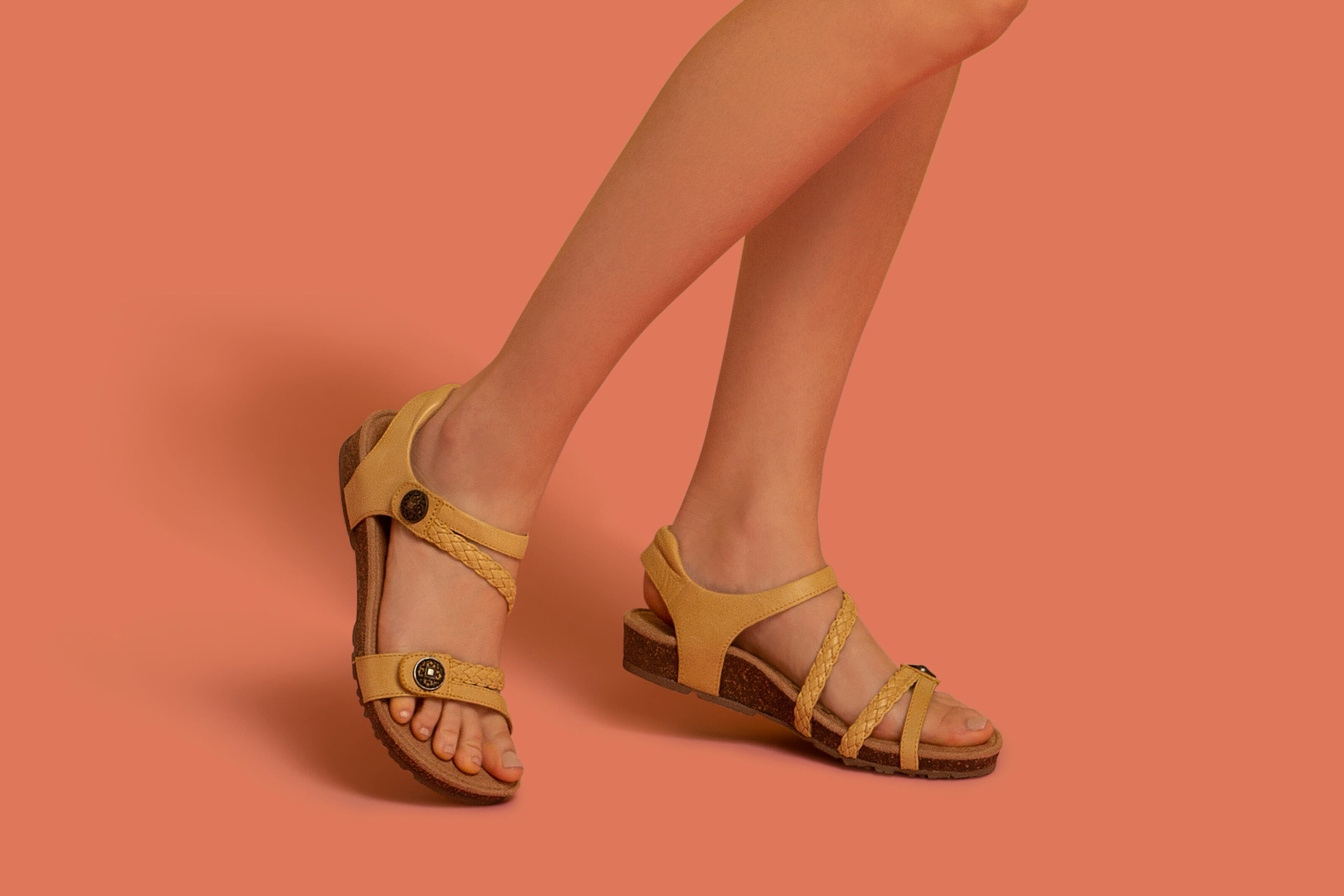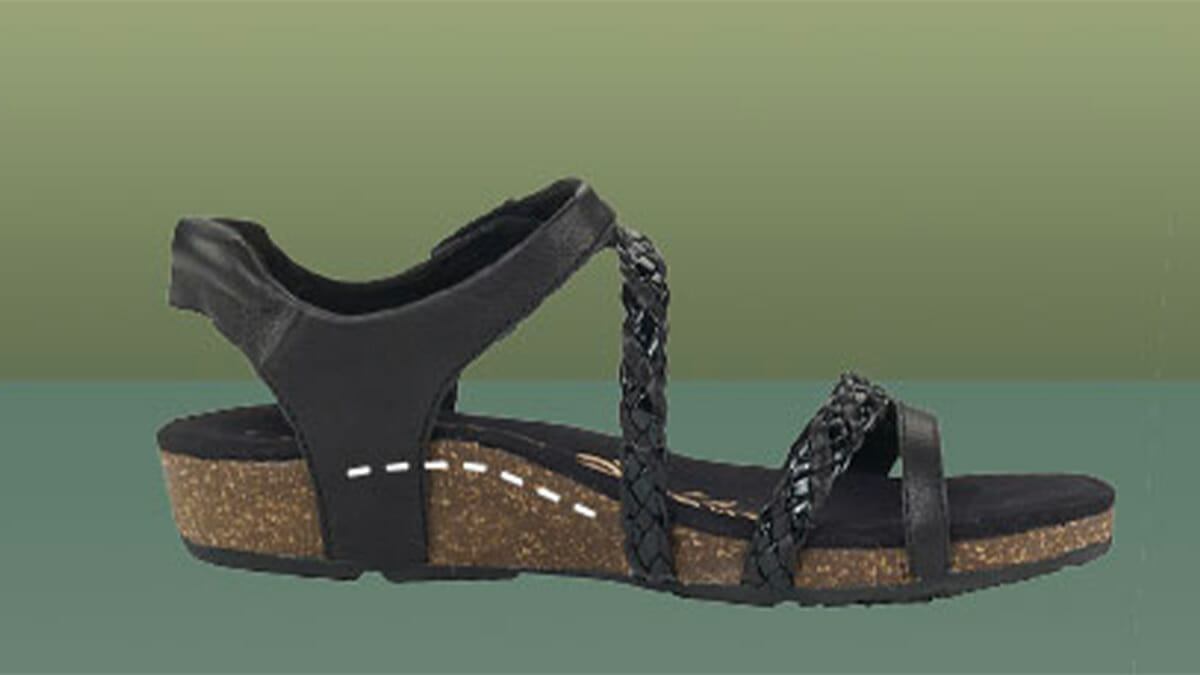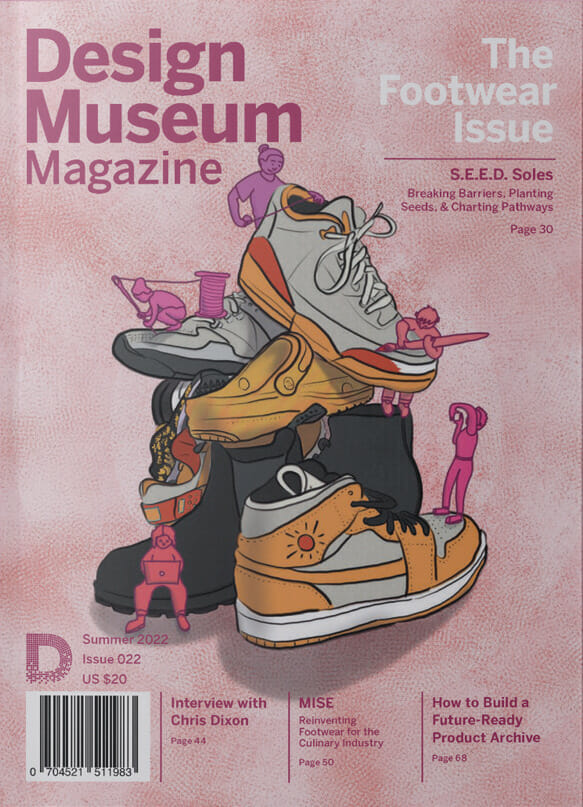Step by Step. Shoe Design and Development

By Susan Ryder, Owner, Susan Ryder Design
On February 2, 1982, I walked into the Nike Research and Development building to start a career as an industrial designer. I knew nothing about shoes. I swam for exercise. Nike was an innovative force at the time—and still is. I got the job as a founding member of the newly formed Advance Concept Lab in Exeter, New Hampshire, in part, by bringing a small flashlight to my portfolio interview which took place in a dark comedy club. They liked my work, but they thought the flashlight was hilarious. Nike was the first to bring industrial design’s problem-solving methodology to the shoe design process and I loved the intersection.
Now, I enjoy my work immensely as a footwear design consultant, as I have the opportunity to work on multiple aspects of shoe brand and product design. Some of my clients have only an idea, a dream and financing. With 40 years of designing shoes, I am now the “Old Shoe Dog,” and my working style is as hands on as it always has been–I still draw with a pencil and cut up samples to see how they are made! I’ll attempt to describe what I have learned in my 40 years of experience to illuminate the process for non-designers and for those who are footwear curious. Keep in mind that every project, client, resource set, timeline and scope will vary, which can impact the exact role of the designer at each phase.
The Kick-off Meeting
The start of a footwear project is similar to many other design projects—the client describes goals and scope, and how the finished product will make a difference in the marketplace. If the product is a full collection of shoes, we map out the number of styles and how they might form a coherent brand statement. We consider the consumer’s identity, their needs, expectations, and emotional connections. We choose the country of manufacture, price target, retail strategy, seasonality and timing and set sustainability goals. We answer the questions: why us? Why now?

Scarlett Chase, a new footwear brand, asked me to manage design and development in 2020. The owner wanted a line of luxury women’s dress shoes as comfortable as athletic shoes. She envisioned a CEO who could walk comfortably from her Paris hotel room to her office in a pair of heels high enough to make her feel powerful and fashionable. We dug deep into this character’s shoe selection process and came up with a list of benefits she would require, some of which involved inventing new ways to construct the classic pump. The line would consist of multiple styles: boots and pumps for fall, and sandals and slides for spring, and would be offered at a price point to support the finest leathers and textiles available.
It’s a mature industry now, so how to keep fresh? Research!
It is the designer’s job to keep up with advancements in manufacturing and technology that allow for design opportunities. In the last few years, a great deal of innovation has focused on sustainability, such as Knit-to-Shape uppers that produce minimal waste. Shoes are normally made of die cut pieces of leather or textile that are overlapped and stitched together flat. Machines use heat and pressure to form them into the shape of the shoe. Factories are pretty good at fitting cutting dies together tightly to maximize material usage, but there is always a pile of scraps that needs to be recycled or thrown away. Alternatively, knit uppers are made like socks, already in the shape of the shoe, and simply need to be cemented to the bottom. No extra material is required.
Getting the colors right
It is important to take into account external market trends, especially when it comes to color. There are trend services that predict color and materials a few years in advance. It is up to the designer to decide to either follow these trends or to create a unique color palette. Companies may have core basic colors (browns, navy, tan, black) that are used season after season. “On-trend” colors can be saved for visual impact or for a specific trade channel. For instance, sandals may feature bright colors for the internet (because they can be seen easily), while neutral colors may apply for more conservative big box and independent retail outlets.
Ideation
In this phase, the designer will come up with multiple options for the shoe design. The first consideration is the shoe’s shape. The shape of the toe, the contours underfoot, and how much the shoe might cup the heel and the arch will determine the fit, style, and the shoe’s construction. The result is a plastic object called a “Last.” Look closely and you can see how the shape of a running shoe is different from that of a basketball shoe. A running shoe is made for repetitive forward movement; a basketball shoe needs to do that too, but also needs to promote lateral stability. The last on most running shoes is lifted higher in the heel for thicker cushioning while simultaneously moderating the impact of heel strike. Basketball shoes are wider to give more surface contact between the foot and the floor, thus giving traction while cutting left and right. All of those considerations go into designing the last.
The second consideration is the silhouette, where the designer must consider upper patterns and the outsole/midsoles/footbeds components and embellishments. We pick the leather or textile upper materials, the lining, threads, type of padding, perf hole size, stitches per inch etc. Trends can upend design, not just with aesthetics but also with function. For a time, minimalist design like barefoot running was trending, but recently massive bottom units like Hoka One One have pushed comfort and cushioning, taking sneaker design for a 180-degree turn. In a multiple shoe collection, the design drawings are organized the way they might be merchandised. Typically, a collection has one design for the cost intense, underfoot molded components. There are multiple designs for the less costly uppers. One bottom and four to six upper styles is common. Each style might be executed in five colors for a total of 30 shoes or Stock Keeping Units (SKU) in the collection. All have to look good on their own, tell the collection’s story, and fit within the brand.

The Concept Comes to Life
Aetrex wanted to make a line of sandals based on their market dominating footbed orthotic. Our first step was to focus on the needs of the consumer, both physically and emotionally. In this ideation, a woman with mild to moderate foot pain needed an everyday sandal. The shoe would have to fit a great many foot types and accommodate unique foot issues such as bunions and arch problems. The line would come in only one width, so the shoe would require fit flexibility from widths B to D. Since everyone’s foot shape is different and foot shape changes over the course of the day, the materials chosen for parts underfoot needed to be soft and accommodating while also providing support. We chose Polyurethane cushioning material that resists compression set (bottoming out) topped with slow compression/ slow recovery memory foam to mold to the unique shape of the consumer’s foot, as well as provide that essential step-in comfort. Fashion trends are important to this consumer, and it was important to have a product that made her feel good about herself. We sculpted the shape of the sandal to be as flattering as possible, while avoiding pressure points around bunion areas and providing obvious structural support. Current trends at the time of that project involved relaxed textures and colors derived from nature, such as neutral colors and grainy unvarnished leather paired with cork. We found leather suppliers with products that fit that description. Urethane molders that would be open to modifying existing techniques and combining foams. We developed unique footbed shapes to make Aetrex’s most popular orthotic into a line of great looking sandals. The line was a success with independent retailers and is still available today.
Documentation
Each product in the collection needs comprehensive specs to tell the manufacturer’s sample room how to make the sample. We document all views of each product including cross sections, make detailed drawings of anything that requires further explanation, note material sources by source, article number, and Pantone numbers, and create blueprints of anything molded. Last shapes are described. There are a number of ways to communicate the design to the factory including sketching directly on the last, Adobe Illustrator, or the use of 3D software. All specs are made in an agreed upon sample size: typically women’s 7 and men’s 9.
Prototyping
These details are sent to the sample factory in the form of a “Tech Pack.” Before Covid, most of us would travel to the factory and work with the last makers, pattern people and mold technicians to supervise the sampling process. If the shoe is relatively straight forward, you might get it in two or three revisions. If it’s not, several more are likely. Designers in large shoe companies may be shaking their heads at this last paragraph. They may have resources to skip all of this and make 3D images or 3D printed versions of their shoe concepts. This saves a lot of time and several trial rounds. All decision makers can be on board before a sample run is made. Eventually though, a wearable shoe sample must be fabricated in order to confirm fit to the foot and to ensure the shoe is tested in the intended environment.
Line Review
As the collection is readying for mass production, the marketing process kicks off. So far, the goal has been to get one perfect sample of each style in one color in a sample size. Once this single pair of shoes is confirmed, samples in other colors and materials are made and reviewed. A final line review will look like a table full of samples laid out the way they would be merchandised in a store. Decision makers may be marketers, sales people, other designers and developers, and the executive suite. Sometimes a company will bring in key retailers to give opinions and direction. All the work, the countless hours comes down to the designer being able to sell his or her vision. Chris Kittle, former VP of Design at Sperry Top-Sider and Cole Haan, writes, “Part of the designers’ job is to be able to sell their ideas. They need to be able to answer the question of what is new about their design, to truly believe in it and be able to communicate it.”
Testing and Commercialization
At this point in the process, the sampled shoe sizes are six or seven for women and size nine for men. All shoes are evaluated for fit and feel. Shoes are tested in their intended context or environment. Testers wear the shoe for about a month and report on any necessary changes. If there are issues, the designs are modified and samples are made again. Once the model is “fit & design” approved at sample size, the next step is the extreme size trial. Here the shoes are graded to a few sizes bigger and a few sizes smaller and tested again.
In the meantime, the factory creates a cost breakdown sheet to ensure the shoes are within the price targets. Here we may make subtle fabrication adjustments to affect manufacturing quality and price: Changing a seam location can make a big difference in optimizing material yields and reducing waste in production.
Duty rates of products coming into the US vary widely. A shoe made of majority leather will cost 10% duty, while a shoe made of textile can cost over 30% duty. The design of the shoe is absolutely influenced by manufacturing adjustments and duty rates.

Pre-Production
Once the extreme size trial is approved for fit, cost and aesthetics, the full-size run is graded. Patterns, gauges, proportions, material physical properties are checked for consistency across the size run. That’s generally 12 sizes for women, 13 for men, or some combination if there is unisex sizing. All molds need to be opened and approved. Designers don’t often participate in the process during pre-production unless a problem crops up.
All the critical ‘extras’
Designers are also responsible for the packaging of shoes, which is important for both shoe protection and brand identity. Logos, box graphics, printed tissue paper, how the shoe is stuffed to maintain shape in the box, and the box itself must have a consistent aesthetic.
This is how it’s done…for now
So much has changed since 1982. Industrial designers were rare, and our problem-solving methodology was novel. Interest in learning about shoe design has mushroomed and college level courses on the subject are easy to find. I am thrilled by the energy and creativity of the new generation of designers. In particular, I am amazed to see the innovation on environmental impact and waste management. Forty years from now, I wonder what will change in the design process and how the industry will be better.
